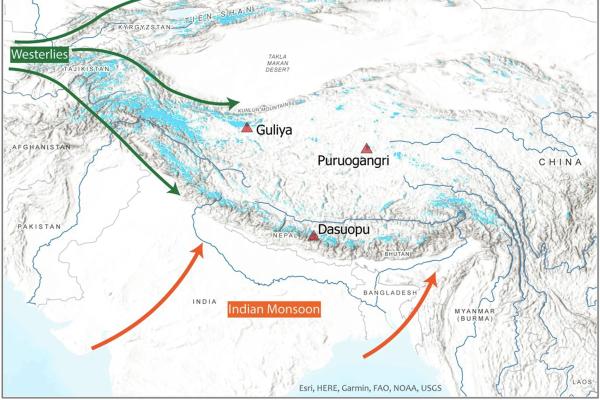Ice Core Study Tracks Lead Pollution Across Asia from Ancient to Modern Times

A new study published in Scientific Data analyzed lead from the third pole ice core samples from the Puruogangri ice cap in central Tibet and the Dasuopu glacier in the central Himalayas to shed light on the historical sources and transport of lead (Pb) pollution across Asia.
Lead is naturally present in various types of rocks. It is primarily released into the environment through rock weathering and volcanic activity. Once introduced, natural processes such as windblown dust, forest fires, biological particles, and sea spray can redistribute lead across the environment.
In contrast, anthropogenic lead is introduced into the atmosphere through the combustion of fossil fuels like coal and leaded gasoline, biomass burning, metal smelting, steel production, and waste incineration. These activities emit lead as fine particulate matter smaller than 2.5 micrometers (PM2.5), which can travel long distances through the atmosphere. This long-range transport leads to the mixing of lead pollution on both hemispheric and global scales.
The research, conducted by Dr. Roxana Sierra-Hernandez, a former senior research associate with the Byrd Center's Ice Core Paleoclimatology research group, professor of geology and geophysics at Texas A&M University Franco Marcantonio, along with Byrd Center's Senior Research Scientists and Distinguished University Professors Lonnie Thompson (Earth Sciences), lead Researcher at the Ice Core Paleoclimatology research group, presents isotopic ratios of lead,204Pb, 206Pb, 207Pb, and 208Pb, from ice cores that span ~36 ka (BP) to 2015. These isotopes serve as tracers, distinguishing between natural and anthropogenic sources.
Ice core records from these high-altitude glaciers, some of the highest drilling sites in the world, capture atmospheric changes across millennia. The Puruogangri ice cap provides a timeline extending to around 14,500 years before present, while the Dasuopu glacier record reaches back approximately 8,600 years. Both sites lie in regions influenced by monsoonal and westerly atmospheric systems, offering a unique perspective on pollution transport across South and Central Asia.
Lead isotope measurements were performed at Texas A&M University using high-resolution multicollector Inductively Coupled Plasma Mass Spectrometry (ICP-MS) technology. Previously used for trace element studies, the samples underwent rigorous decontamination and preparation procedures to ensure data quality. The results reveal elevated lead concentrations linked to natural environmental events and industrial activity, particularly in recent centuries.
This study provides a unique dataset of Pb isotope ratios from two ice cores in Tibet (Puruogangri) and the Himalayas (Dasuopu) that researchers can use to compare with their own data to determine the origin of Pb in their samples. By comparing the isotopic signatures in ice cores with known natural and anthropogenic sources, researchers can trace the geographical origins of pollutants and better understand how they have changed over time.
All study data are publicly accessible through the NOAA National Centers for Environmental Information, supporting further research into global pollution histories and long-range atmospheric transport processes.
